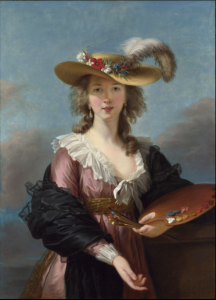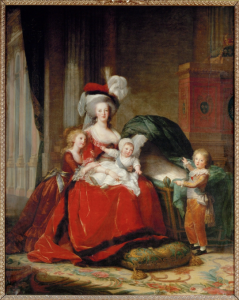30 Style Evolution of Marie Antoinette – Élisabeth Louise Vigée Le Brun

April 16, 1755-March 30, 1842
Élisabeth Louise Vigée Le Brun was a prolific late 18th-century portrait painter, estimated to have produced over 600 paintings. Her great contribution to French female portraiture is noted as introducing an informality of pose and simplicity of costume, which opposes the structure and rules of Neoclassicism. Born to, and student of, portraitist Louis Vigée, she also studied with Gabriel-François Doyen and took advice from family friends, Claude-Joseph Vernet and Jean-Baptiste Greuze. She began painting professionally in her early teens, and was fined for practicing without a license.
At age 21, she married Jean-Baptiste-Pierre Le Brun, a rapacious art dealer, whose great-great-uncle, Charles Le Brun, was the first director of the French Academy under Louis XIV. Her patrons became aristocrats, artists, writers, and ultimately Marie Antoinette; Vigée Le Brun painted at least 25 portraits of the Queen and is as much responsible for Marie Antoinette’s status as a fashion icon as Rose Bertin and Monsieur Léonard. Her most spectacular portrait of the queen is said to be the full-length, Marie-Antoinette and her Children (1787) [Figure 2]. It was this relationship that secured Vigée Le Brun’s place as only one of fifteen women admitted into the Académie Royale de Peinture et de Sculpture between 1648 and 1793.

Vigée Le Brun’s work was itself scandalous, the best known example may be, Marie-Antoinette en gaulle (1783), where the queen is only wearing a white cotton garment. Even before though, Vigée Le Brun caused a scandal when she painted self-portraits alone or with her daughter where she is smiling and in some cases you can see her teeth [Figure 1]. This break from convention caused contention over 15o years later when Simone de Beauvoir referred to her “smiling maternity” as narcissistic in The Second Sex.
In October 1789, Vigée Le Brun fled France with her daughter, Julie, fearing for their safety; this also provided an escape from her wretched marriage. Over the next twelve years she traveled to Italy, Austria, Russia and Germany taking commissions and was elected to art academies in 10 cities. Only when her name was removed from the list of counter-revolutionaries did she return to a Napoleonic Paris, which she found pretentious and bourgeois.
Bibliography of Sources:
“Élisabeth Louise Vigée Le Brun.” Wikipedia: The Free Encyclopedia. Accessed May 22, 2019. https://en.wikipedia.org/wiki/Élisabeth_Vigée_Le_Brun.
Jordan, Marc. “Vigée-Lebrun, Élisabeth-Louise.” In The Oxford Companion to Western Art. : Oxford University Press, 2001. Accessed May 22, 2019. https://www-oxfordreference-com.offcampus.lib.washington.edu/view/10.1093/acref/9780198662037.001.0001/acref-9780198662037-e-2706.
Vigée-Lebrun, Louise-Elisabeth, Baillio, Joseph, Baetjer, Katharine, Lang, Paul, Deryabina, Ekaterina, Firmin, Gwenola, Guégan, Stéphane, Poňka, Anabelle Kienle, Salmon, Xavier, Sulimova, Anna, and Metropolitan Museum of Art , Issuing Body, Host Institution. Vigée Le Brun. New York: Metropolitan Museum of Art, 2016.
Image Captions:
Fig. 1. Elisabeth Louise Vigée-LeBrun, Self Portrait in a Straw Hat. After 1782, oil on canvas, 97.8 x 70.5 cm. Repository of The National Gallery (London, England). Available from: ARTstor. Accessed May 22, 2019. http://www.artstor.org.
Fig. 2. Elisabeth Louise Vigée-LeBrun, Queen Marie-Antoinette and her Children. 1787, oil on canvas, 275 x 215 cm. Repository of Château de Versailles (Versailles, France). Available from: ARTstor. Accessed May 22, 2019. http://www.artstor.org.


Feedback/Errata